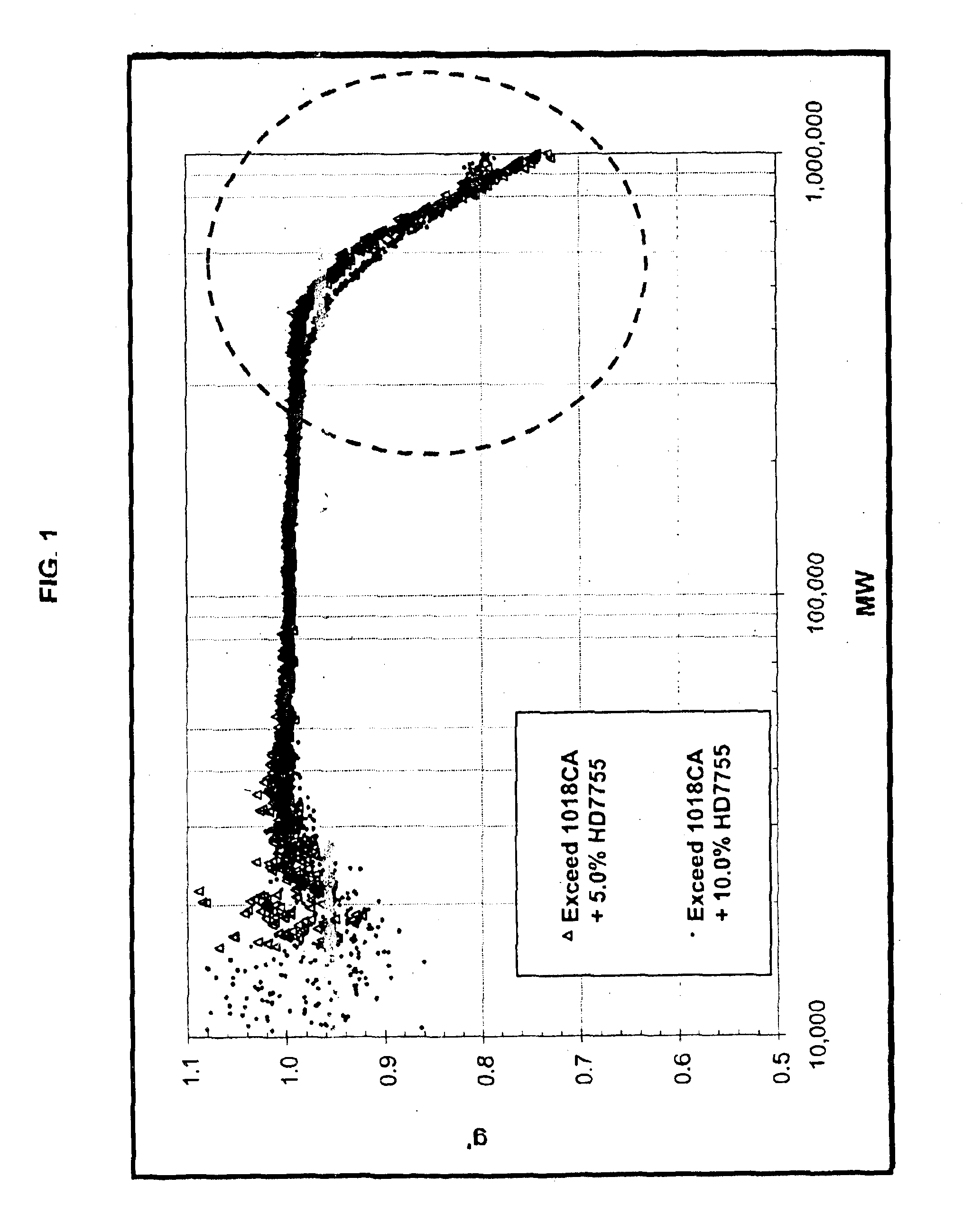Low haze high strength polyethylene compositions
a high-strength polyethylene, low-haze technology, applied in the field of polyethylene compositions, can solve the problems that the improvement of haze levels at a given film stiffness tends to be accompanied by loss of dart impact and/or other strength properties
- Summary
- Abstract
- Description
- Claims
- Application Information
AI Technical Summary
Benefits of technology
Problems solved by technology
Method used
Image
Examples
specific embodiments
One or more specific embodiments are directed to a low density substantially linear polyethylene composition preferably having: (a) a density of 0.935 g / cc or less; (b) a Haze of 10% or less, (c) a Dart Impact of 100 grams / mil or more, (d) an average long chain branching index of 0.95 or more; and (e) a slice long chain branching index of 0.85 or less for any portion of the composition having a molecular weight of 100,000 or above.
Alternatively, the slice long chain branching index (also referred to as the SLCB index) can be 0.80 or less for any portion of the composition having a molecular weight of 100,000 or above. Alternatively, a composition may have a slice long chain branching (SLCB) index of 0.75 or less, or 0.70 or less, or 0.65 or less, or 0.60 or less, for any portion of the composition having a molecular weight of 100,000 or above. For example, as seen in FIG. 1, the plotted curves based on actual data demonstrate a pronounced nosedive in the plotted SLCB index along the...
example 1
Table 1 shows various properties and processing conditions of four different film samples made from unblended compositions consisting only of Exceed™ 1018CA, a linear low density polyethylene (LLDPE) product sold by ExxonMobil Chemical Co., having a nominal density of 0.918 g / cc a nominal MI of 1.0 dg / min and an average LCB index (g′) of greater than 0.97. In general, an LLDPE product useful herein preferably has a density ranging from 0.918 to 0.922 g / cm3, an MI of 0.8 to 1.2 dg / min and an average g′ greater than 0.97. Samples 1 and 2 are film samples made from Exceed 1018CA in the First Blend Study that was conducted, and the same lot of Exceed 1018CA resin was included in the blend compositions referenced in Table 2. Samples 3 and 4 are film samples made from Exceed 1018CA in the Second Blend Study that was conducted, and the same lot of Exceed 1018CA was included in the blend compositions referenced in Table 3.
TABLE 1First Blend StudySecond Blend StudySample 1Sample 2Sample 3Sam...
example 2
Table 2 describes twenty-one samples of compositions made from seven polyethylene resins blended in varying amounts with Exceed 1018CA resin, including the Haze and Dart Impact of films made from the compositions, as well as the wt % of composition having g′≦0.90.
The LD 200 product is a high pressure low density polyethylene (HP-LDPE) resin sold commercially by ExxonMobil. The LD 113 product is another high pressure low density polyethylene resin sold commercially by ExxonMobil. The DYNH-1 product is a high pressure low density polyethylene resin sold by Dow Chemical Co. The EXP product is an experimental substantially linear low density polyethylene product. HD 9856B, HDZ 222 and HD 6704 are different high density polyethylene (HDPE) grades sold for different applications by ExxonMobil.
All the film samples in Table 2 were made with same machine set-up used in making Samples 1 and 2 described in Table 1, i.e., the First Blend Study. That is, the components were dry-blended, accordin...
PUM
| Property | Measurement | Unit |
|---|---|---|
| Fraction | aaaaa | aaaaa |
| Linear density | aaaaa | aaaaa |
| Linear density | aaaaa | aaaaa |
Abstract
Description
Claims
Application Information
 Login to View More
Login to View More - R&D
- Intellectual Property
- Life Sciences
- Materials
- Tech Scout
- Unparalleled Data Quality
- Higher Quality Content
- 60% Fewer Hallucinations
Browse by: Latest US Patents, China's latest patents, Technical Efficacy Thesaurus, Application Domain, Technology Topic, Popular Technical Reports.
© 2025 PatSnap. All rights reserved.Legal|Privacy policy|Modern Slavery Act Transparency Statement|Sitemap|About US| Contact US: help@patsnap.com



